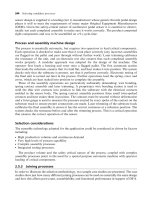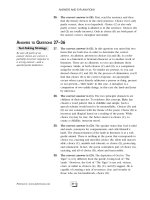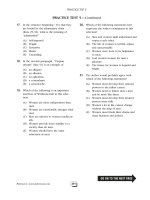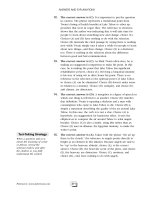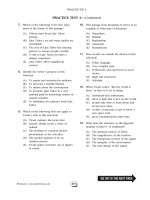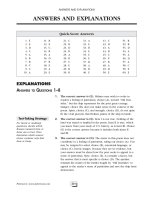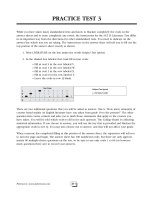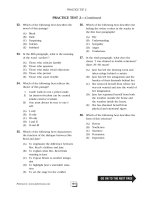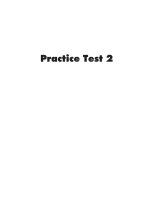SAT II success literature Episode 2 Part 5 docx
Bạn đang xem bản rút gọn của tài liệu. Xem và tải ngay bản đầy đủ của tài liệu tại đây (111.94 KB, 20 trang )
7. Which of the following is the best state-
ment of the theme of this passage?
(A) Visitors must keep Lake Tahoe
pristine.
(B) Lake Tahoe’s air and water quality are
remarkable.
(C) The area of Lake Tahoe has amazing
powers to restore people’s health.
(D) A visit to Lake Tahoe provides a
unique experience.
(E) Lake Tahoe offers magnificent
scenery.
8. Identify the writer’s purpose in this
selection.
(A) To amuse and entertain his audience
(B) To advocate a healthy lifestyle
(C) To inform about the environment
(D) To promote Lake Tahoe as a new
national park by interesting readers in
natural wonders
(E) To familiarize his audience with Lake
Tahoe
9. Which of the following does not apply to
Twain’s style in this selection?
(A) Twain captures the local color.
(B) Specific details create a sense of
realism.
(C) The rhythms of common speech
predominate in the selection.
(D) The speaker appears to be an
ordinary person.
(E) Twain makes extensive use of figures
of sound.
10. This passage from Roughing It serves as an
example of what type of literature?
(A) Naturalism
(B) Realism
(C) Regionalism
(D) Classicism
(E) Romanticism
11. How would you classify the diction in this
selection?
(A) Folksy language
(B) Very complex style
(C) Perfunctory and capricious in word
choice
(D) Rigid and structured
(E) Scholarly
12. When Twain writes, “But the world is
slow,” in lines 8–9, he is saying
(A) individuals lack enthusiasm.
(B) there is little that is new in the world.
(C) people take time to learn about and
accept new ideas.
(D) it takes a long time to get to know a
new place well.
(E) good communication takes time.
13. What does the reference to the Egyptian
mummy in lines 9–12 emphasize?
(A) The spiritual essence of Tahoe
(B) The magnificence of the territory
(C) The therapeutic powers of the region
(D) The antiquity of the environment
(E) The arid climate of the region
PRACTICE TEST 4
PRACTICE TEST 4—Continued
➡
GO ON TO THE NEXT PAGE
251Peterson’s: www.petersons.com
14. Which of the following is an example of a
metaphor?
(A) “the same the angels breathe”
(line 14)
(B) “The air up there is very pure and
fine.” (lines 12–13)
(C) “appetite like an alligator” (line 11)
(D) “He was a skeleton when he came”
(lines 18–19)
(E) “restore an Eyptian mummy to his
pristine vigor” (line 10)
15. When Twain states the air is “the same the
angels breathe” (line 14), he is alluding to
what aspect of the environment?
(A) The altitude
(B) The heavenly scent from the pines
(C) The moisture
(D) The cold
(E) The heavens
16. From your reading of this passage, what
conclusions can you draw about Mark
Twain’s feelings for Lake Tahoe?
(A) The author finds the area and its
inhabitants amusing.
(B) Twain likes the area.
(C) He wishes that it were not quite so
cold.
(D) The writer has deeper feelings for the
Mississippi River.
(E) He feels the area lacks the cultural
depth of the East.
SAT II SUCCESS: LITERATURE
PRACTICE TEST 4—Continued
252 Peterson’s SAT II Success: Literature
Questions 17–24 refer to the following poem, written during the
Elizabethan period in England. Read the passage carefully and then
choose the answers to the questions.
Sonnet 55
Line Not marble, nor the guilded monuments
Of princes shall outlive this powerful rhyme;
But you shall shine more bright in these contents
Than unswept stone, besmeared with sluttish time.
When wasteful war shall statues overturn,
And broils root out the work of masonry,
Nor Mars his sword nor war’s quick fire shall burn
The living record of your memory.
’Gainst death and all-oblivious enmity
Shall you pace forth; your praise shall still find room
Even in the eyes of all posterity
That wear this world out to the ending doom.
So, till the judgment that yourself arise,
You live in this, and dwell in lovers’ eyes.
—William Shakespeare
17. Identify the speaker and the person
addressed in this poem.
(A) William Shakespeare and Queen
Elizabeth I
(B) A friend of the poet and the dark lady
(C) The writer’s lover and the reader
(D) A speaker as a lover and the speaker’s
idealized friend or lover
(E) “You” and a beautiful, but coy,
woman
18. Identify the subject of this poem.
(A) The apocalypse, doomsday
(B) The memory of the speaker’s beloved
(C) The deathlessness of love
(D) Demise and devotion
(E) Bloodshed and time
19. Which of the following best depicts the
theme of the poem?
(A) A writer can conquer death.
(B) Literature, especially poetry, cannot
be a ruinous force.
(C) Memories of love endure for all
people.
(D) Poetry and the memory of the person
about whom this poem is written will
outlive physical things.
(E) War exhausts and destroys.
PRACTICE TEST 4
PRACTICE TEST 4—Continued
5
10
➡
GO ON TO THE NEXT PAGE
253Peterson’s: www.petersons.com
20. Which of the following is not identified by
the poet as a power of destruction?
(A) Rancorous forgetfulness
(B) Death
(C) The span of time
(D) Warfare
(E) Callous loathing
21. To which of the following does the poet
allude in the poem?
I. Judgment Day
II. The god of war
III. The goddess of love
(A) I only
(B) II only
(C) III only
(D) I and II
(E) I, II, and III
22. Which of the following is the best interpre-
tation of lines 7 and 8, which complete the
octet?
(A) The lines introduce hidden, mystical
content.
(B) They allude to Doomsday.
(C) The lines restate the idea that this
poem will endure through time.
(D) They reinforce the ideas of violence,
destruction, and war described in the
poem.
(E) The lines express Shakespeare’s fear
of his beloved’s death.
23. What is the meaning of the phrase “sluttish
time” (line 4)?
(A) Time can be indiscriminate and
wanton when it comes to destruction.
(B) Time is similar to a licentious woman.
(C) With the end of time will come all
forms of horrors.
(D) In time everything will be destroyed.
(E) Wasting time is reckless.
24. Which of the following ideas does the
speaker state in the couplet?
(A) The beloved will live on through this
poem and in lovers’ eyes.
(B) The god of war brings doom.
(C) Time is the ultimate destroyer.
(D) Poetry produces significant ideas.
(E) The beloved will rise again on
Judgment Day.
SAT II SUCCESS: LITERATURE
PRACTICE TEST 4—Continued
254 Peterson’s SAT II Success: Literature
Questions 25–36 refer to the following selection, written during the
Romantic period in England. Read the passage carefully and then
choose the answers to the questions.
From “Introduction” to Frankenstein
Line The Publishers of the Standard Novels, in selecting Frankenstein for
one of their series, expressed a wish that I should furnish them with
some account of the origin of the story. I am the more willing to
comply, because I shall thus give a general answer to the question, so
very frequently asked me: “How I, then a young girl, came to think
of, and to dilate upon, so very hideous an idea?” It is true that I am
very averse to bringing myself forward in print; but as my account
will only appear as an appendage to a former production, and as it
will be confined to such topics as have connection with my author-
ship alone, I can scarcely accuse myself of a personal intrusion
In the summer of 1816, we visited Switzerland, and became the
neighbors of Lord Byron. At first we spent our pleasant hours on the
lake or wandering on its shores; and Lord Byron, who was writing
the third canto of Childe Harold, was the only one among us who
put his thoughts upon paper. These, as he brought them successively
to us, clothed in all the light and harmony of poetry, seemed to
stamp as divine the glories of heaven and earth, whose influences we
partook with him.
But it proved a wet, ungenial summer, and incessant rain often
confined us for days to the house. Some volumes of ghost stories,
translated from the German into French fell into our hands. There
was “The History of the Inconstant Lover,” who, when he thought to
clasp the bride to whom he had pledged his vows, found himself in
the arms of the pale ghost of her whom he had deserted. There was
the tale of the sinful founder of his race, whose miserable doom it
was to bestow the kiss of death on all the younger sons of his fated
house, just when they reached the age of promise. His gigantic,
shadowy form, clothed like the ghost in Hamlet waslost beneath
the shadow of the castle wall but soon a gate swung back, a step was
heard, the door of the chamber opened, and he advanced to the
couch of the blooming youths, cradled in healthy sleep. Eternal
sorrow sat upon his face as he bent down and kissed the foreheads of
the boys, who from that hour withered like flowers snapped upon
the stalk
PRACTICE TEST 4
PRACTICE TEST 4—Continued
5
10
15
20
25
30
➡
GO ON TO THE NEXT PAGE
255Peterson’s: www.petersons.com
“We will each write a ghost story,” said Lord Byron; and his
proposition was acceded to. There were four of us. The noble author
began a tale, a fragment of which he printed at the end of his poem
of Mazeppa. Shelley, more apt to embody ideas and sentiments in the
radiance of brilliant imagery, and in the music of the most melodious
verse that adorns our language, than to invent the machinery of a
story, commenced one founded on the experiences of his early life.
Poor Polidori had some terrible idea about a skull-headed lady
The illustrious poets also, annoyed by the platitude of prose, speedily
relinquished their uncongenial task.
I busied myself to think of a story—a story to rival those which
had excited us to this task. One which would speak to the mysterious
fears of our nature and awaken thrilling horror—one to make the
reader dread to look round, to curdle the blood, and quicken the
beatings of the heart. If I did not accomplish these things, my ghost
story would be unworthy of its name. I thought and pondered—
vainly. I felt that blank incapability of invention which is the greatest
misery of authorship, when dull Nothing replies to our anxious
invocations. Have you thought of a story? I was asked each
morning, and each morning I was forced to reply with a mortifying
negative
Many and long were the conversations between Lord Byron and
Shelley, to which I was a devout but nearly silent listener. During one
of these, various philosophical doctrines were discussed, and among
others the nature of the principle of life and whether there was any
probability of its ever being discovered and communicated
Perhaps a corpse would be reanimated: galvanism had given token of
such things. Perhaps the component parts of a creature might be
manufactured, brought together, and endued with vital warmth.
Night waned upon this talk, and even the witching hour had
gone by, before we retired to rest. When I placed my head on my
pillow, I did not sleep, nor could I be said to think. My imagination,
unbidden, possessed and guided me, gifting the successive images
that arose in my mind with a vividness far beyond the usual bounds
of reverie. I saw—with shut eyes but acute mental vision—I saw the
pale student of unhallowed arts kneeling beside the thing he had put
together. I saw the hideous phantasm of a man stretched out, and
then, on the working of some powerful engine, show signs of life and
stir with an uneasy, half vital motion. Frightful must it be, for
supremely frightful would be the effect of any human endeavor to
mock the stupendous mechanism of the Creator of the world. His
success would terrify the artist; he would rush away from his odious
handiwork, horror-stricken. He would hope that, left to itself, the
SAT II SUCCESS: LITERATURE
PRACTICE TEST 4—Continued
35
40
45
50
55
60
65
70
75
256 Peterson’s SAT II Success: Literature
slight spark of life which he had communicated would fade; that this
thing, which had received such imperfect animation, would subside
into dead matter; and he might sleep in the belief that the silence of
the grave would quench forever the transient existence of the
hideous corpse which he had looked upon as the cradle of life. He
sleeps; but he is awakened; he opens his eyes; behold the horrid
thing stands at his bedside, opening his curtains, and looking on him
with yellow, watery, but speculative eyes.
I opened mine in terror. The idea so possessed my mind, that a
thrill of fear ran through me, and I wished to exchange the ghastly
image of my fancy for the realities around. I see them still: the very
room, the dark parquet, the closed shutters, with the moonlight
struggling through, and the sense I had that the glassy lake and white
high Alps were beyond. I could not so easy get rid of my hideous
phantom: still it haunted me. I must try to think of something else. I
recurred to my ghost story—my tiresome unlucky ghost story! O! if I
could only contrive one which would frighten my reader as I myself
had been frightened that night!
Swift as light and as cheering was the idea that broke in upon
me. “I have found it! What terrified me will terrify others, and I need
only describe the specter which haunted my midnight pillow.” On
the morrow I announced that I had thought of a story. I began that
day with the words, It was on a dreary night of November, making
only a transcript of the grim terrors of my waking dream.
At first I thought but of a few pages—of a short tale—but
Shelley urged me to develop the idea at greater length. I certainly did
not owe the suggestion of one incident, nor scarcely of one train of
feeling, to my husband, and yet but for his incitement, it would never
have taken the form in which it is presented to the world. From this
declaration I must except the preface. As far as I can recollect, it was
entirely written by him.
And now, once again, I bid my hideous progeny go forth and
prosper. I have an affection for it, for it was the offspring of happy
days, when death and grief were but words, which found no true
echo in my heart. Its several pages speak of many a walk, many a
drive, and many a conversation, when I was not alone; and my
companion was one who, in this world, I shall never see more. But
this is for myself: my readers have nothing to do with these associa-
tions.
—Mary Shelley
PRACTICE TEST 4
PRACTICE TEST 4—Continued
80
85
90
95
100
105
110
115
➡
GO ON TO THE NEXT PAGE
257Peterson’s: www.petersons.com
25. What is the function of the first paragraph?
I. To explain why the author wrote
Frankenstein
II. To answer a question frequently
asked of her
III. To explain the impetus for writing
this “Introduction”
(A) I only
(B) II only
(C) III only
(D) I and III
(E) II and III
26. Which of the following does not describe
the overall tone of the passage?
(A) Dark
(B) Chilling
(C) Introspective
(D) Personal
(E) Emotional
27. To whom is Shelley referring in the last
paragraph when she says “my companion”?
(A) Lord Byron
(B) Frankenstein
(C) Her husband, Percy Bysshe Shelley
(D) Byron, Percy Shelley, Polidori
(E) An unknown person
28. What is the mode of discourse of this
selection?
(A) Argument
(B) Exposition
(C) Description
(D) Narrative
(E) Persuasion
29. Which of the following best describes the
task Shelley faces in this selection?
I. An external challenge from her
companions to write a ghost story
II. An internal challenge from herself to
write a good horror story
III. An internal challenge to write a new
introduction to awaken interest in
Frankenstein
(A) I only
(B) II only
(C) III only
(D) I and II
(E) II and III
30. All of the following images refer to
Frankenstein EXCEPT
(A) “speculative eyes” (line 85).
(B) “imperfect animation” (line 79).
(C) “hideous phantasm” (lines 91–92).
(D) “stupendous mechanism” (line 75).
(E) “cradle of life” (line 82).
31. All of the following elements of style can
be found in this passage EXCEPT
(A) vivid language.
(B) sophisticated diction.
(C) objective narrator.
(D) dialogue.
(E) sensory images.
SAT II SUCCESS: LITERATURE
PRACTICE TEST 4—Continued
258 Peterson’s SAT II Success: Literature
32. From the sixth paragraph, the reader can
find or infer all of the following EXCEPT
(A) Lord Byron and Shelley conversed
while the author listened.
(B) The author’s companions enjoyed
philosophical discussions.
(C) Scientists were actively exploring the
principle of life even then.
(D) The author was interested in the idea
of life being created.
(E) The author implies that these talks
provided the seed for her dream.
33. What is the meaning of the word
“galvanism” in the sentence in the sixth
paragraph beginning “Perhaps a corpse
would be reanimated ”(lines 61–62)?
(A) The use of a direct current of
electricity to stimulate something
(B) To give life to a nonhuman object
(C) To coat metal with zinc to prevent
rust
(D) To spur to action
(E) Convulsive
34. Which of the following best describes the
subtext of the author’s reverie in the
seventh paragraph?
I. The dangers of theories
II. The dangers of trying to create life in
a laboratory
III. The dangers of science in the wrong
hands
(A) I only
(B) II only
(C) III only
(D) I and II
(E) II and III
35. What is the significance of the fact that it
rained incessantly that summer?
(A) The rain limited boating and other
outside activities.
(B) The confinement forced the writers
to otherwise occupy themselves.
(C) The rain created a dark mood, perfect
for writing.
(D) The rain made the friends rely more
heavily on one another for fun.
(E) The rain made the writers irritable
and antisocial.
36. To what sense do most of the images in
the seventh paragraph appeal?
(A) Hearing
(B) Touch
(C) Sight
(D) Smell
(E) Taste
PRACTICE TEST 4
PRACTICE TEST 4—Continued
➡
GO ON TO THE NEXT PAGE
259Peterson’s: www.petersons.com
Questions 37–42 refer to the following poem from the Harlem
Renaissance. Read the passage carefully and then choose the answers
to the questions.
We Wear the Mask
Line We wear the mask that grins and lies,
It hides our cheeks and shades our eyes—
The debt we pay to human guile;
With torn and bleeding hearts we smile,
And mouth with myriad subtleties.
Why should the world be overwise,
In counting all our tears and sighs?
Nay, let them only see us, while
We wear the mask.
We smile, but, O great Christ, our cries
To thee from tortured souls arise.
We sing, but oh the clay is vile
Beneath our feet, and long the mile;
But let the world dream otherwise.
We wear the mask!
—Paul Dunbar
37. The title of the poem introduces the
reader to all of the following EXCEPT
(A) the main idea of the poem.
(B) the theme of the poem.
(C) the image of the mask.
(D) the metaphor of the mask.
(E) the symbolism of the mask.
38. In the first stanza, why do you think the
author chose the images of “cheeks” and
“eyes”?
(A) The eyes are the mirror of the soul.
(B) Some physical manifestations of
emotion cannot be controlled.
(C) The smiling face masks the anger and
suffering of African Americans.
(D) People’s faces change when they
grin.
(E) A person’s face reflects his or her
feelings.
SAT II SUCCESS: LITERATURE
PRACTICE TEST 4—Continued
5
10
15
260 Peterson’s SAT II Success: Literature
39. Which of the following best describes the
theme of the poem?
I. To survive in a white world, African
Americans must hide their true
feelings.
II. African Americans are suffering but
feel compelled to hide behind a
pleasant exterior.
III. African Americans choose to deceive
white people by wearing masks.
(A) I only
(B) II only
(C) III only
(D) I and II
(E) I, II, and III
40. Which of the following best describes the
emotional state of the speaker?
(A) Anguished
(B) Unhappy
(C) Troubled
(D) Distressed
(E) Angry
41. Which of the following is the dominant
literary device in this poem?
(A) Personification
(B) Simile
(C) Metaphor
(D) Apostrophe
(E) Conceit
42. In the title and in each of the three
stanzas, why do you think the author
chose to repeat the phrase “We wear the
mask”?
I. To add to the musicality of the poem
II. To underscore the suffering
III. To evoke an emotional response from
the reader
(A) I only
(B) II only
(C) III only
(D) I and II
(E) II and III
PRACTICE TEST 4
PRACTICE TEST 4—Continued
➡
GO ON TO THE NEXT PAGE
261Peterson’s: www.petersons.com
Questions 43–50 refer to the following selection, written before the
Civil War. Read the passage carefully and then choose the answers to
the questions.
From “Preface” to the 1855 Edition of
Leaves of Grass
Line America does not repel the past or what it has produced under its
forms or amid other politics or the idea of castes or the old religions
. . . accepts the lesson with calmness isnotsoimpatient as has
been supposed that the slough still sticks to opinions and manners
and literature while the life which served its requirements has passed
into the new life of the new forms perceives that the corpse is
slowly borne from the eating and sleeping rooms of the house
perceives that it waits a little while in the door that it was fittest
foritsdays that its action has descended to the stalwart and
well-shaped heir who approaches andthat he shall be fittest for
his days.
The Americans of all nations at any time upon the earth have
probably the fullest poetical nature. The United States themselves are
essentially the greatest poem. In the history of the earth hitherto the
largest and most stirring appear tame and orderly to their ampler
largeness and stir. Here at last is something in the doings of man that
corresponds with the broadcast doings of the day and night. Here is
not merely a nation but a teeming nation of nations. Here is action
untied from strings necessarily blind to particulars and details
magnificently moving in vast masses. Here is the hospitality which
forever indicates heroes Here are the roughs and beards and
space and ruggedness and nonchalance that the soul loves. Here the
performance disdaining the trivial unapproached in the tremendous
audacity of its crowds and groupings and the push of its perspective
spreads with crampless and flowing breadth and showers its prolific
and splendid extravagance. One sees it must indeed own the riches
of the summer and winter, and need never bankrupt while corn
grows from the ground or orchards drop apples or the bays contain
fish or men beget children upon women
—Walt Whitman
SAT II SUCCESS: LITERATURE
PRACTICE TEST 4—Continued
5
10
15
20
25
262 Peterson’s SAT II Success: Literature
43. Which of the following statements best
characterizes the theme of this passage?
(A) A word picture of the majesty of the
United States
(B) A merging of modern and former
styles of poetry
(C) A prediction regarding the future of
literature in the United States
(D) A discussion of the resources,
populace, and poetry of the United
States
(E) A poetic definition of the United
States
44. Which of the following statements does
not reflect Whitman’s ideas?
(A) The people of the United States have
built a unique nation.
(B) The people of the United States must
work day and night to ensure their
prosperity.
(C) The United States is a country of vast
riches—in people and nature.
(D) The United States is a nation in
transition.
(E) The people of the United States have
thrown off old ways.
45. Which of the following defines Whitman’s
style?
I. Long, involved sentences
II. Alliteration
III. Parallel structure
(A) I only
(B) II only
(C) I and II
(D) I and III
(E) I, II, and III
46. How does Whitman suggest that the past
and the present are linked?
(A) The past complicates the present.
(B) In the present, the past is viewed
differently.
(C) The present is merely a mirror image
of the past.
(D) The present can only be seen in the
context of the past.
(E) The past nourishes and educates the
present.
47. Whitman’s use of the word “corpse” in
line 6 employs what type of literary
device?
(A) Personification
(B) Metaphor
(C) Synecdoche
(D) Apostrophe
(E) Trope
48. Which is the best interpretation of the
statement “the United States themselves
are essentially the greatest poem,”
lines 13–14?
(A) The United States produces the
greatest volume of good poetry in the
Western world.
(B) The United States consistently takes
the lead in inventing new forms of
poetry and prose.
(C) Americans display all the imaginative
qualities found in good poetry.
(D) The nation’s vibrancy, beauty, and
diversity are poetic.
(E) The foundation of American literature
is poetry.
PRACTICE TEST 4
PRACTICE TEST 4—Continued
➡
GO ON TO THE NEXT PAGE
263Peterson’s: www.petersons.com
49. In the second paragraph, “here” is used to
begin many sentences. What tone does
that repetition create?
(A) A musical, poetic sense
(B) A formal feeling
(C) Exuberance
(D) A sense of predictability and comfort
(E) A weighty, antiquated manner
50. The compound verb in the sentence
beginning “Here the performance ”
(lines 22–26) is
(A) “push” (line 24) and “spreads”
(line 25).
(B) “unapproached” (line 23) and
“showers” (line 25).
(C) “spreads” (line 25) and “showers”
(line 25).
(D) “unapproached” (line 23) and
“disdaining” (line 23).
(E) “crowds” (line 24) and “showers”
(line 25).
SAT II SUCCESS: LITERATURE
PRACTICE TEST 4—Continued
264 Peterson’s SAT II Success: Literature
Questions 51–60 refer to the following poem, written during the
New England Renaissance. Read the passage carefully and then
choose the answers to the questions.
The Chambered Nautilus
Line This is the ship of pearl, which, poets feign,
Sails the unshadowed main–
The venturous bark that flings
On the sweet summer wind its purpled wings
In gulfs enchanted, where the Siren sings,
And coral reefs lie bare,
Where the cold sea-maids rise to sun their streaming hair.
Its webs of living gauze no more unfurl;
Wrecked is the ship of pearl!
And every chambered cell,
Where its dim dreaming life was wont to dwell,
As the frail tenant shaped his growing shell,
Before thee lies revealed–
Its irised ceiling rent, its sunless crypt unsealed!
Year after year beheld the silent toil
That spread his lustrous coil;
Still, as the spiral grew,
He left the past year’s dwelling for the new,
Stole with soft step its shining archway through,
Built up its idle door,
Stretched in his last-found home, and knew the old no more.
Thanks for the heavenly message brought by thee,
Child of the wandering sea,
Cast from her lap, forlorn!
From thy dead lips a clearer note is born
Than ever Triton blew from wreathèd horn!
While on mine ear it rings,
Through the deep caves of thought I hear a voice that sings:
Build thee more stately mansions, O my soul,
As the swift seasons roll!
Leave thy low-vaulted past!
Let each new temple, nobler than the last,
Shut thee from heaven with a dome more vast,
Till thou at length art free,
Leaving thine outgrown shell by life’s unresting sea!
—Oliver Wendell Holmes
PRACTICE TEST 4
PRACTICE TEST 4—Continued
5
10
15
20
25
30
35
➡
GO ON TO THE NEXT PAGE
265Peterson’s: www.petersons.com
51. What message does this poem convey?
(A) It is important to keep growing
throughout life.
(B) Study and appreciate creatures from
nature.
(C) Build greater and more elegant
edifices.
(D) Listen to that voice in the shell.
(E) Love all of God’s creations, including
human beings.
52. Which of the following best identifies the
tone of this poem?
(A) Admiring, fanciful
(B) Cynical, incisive
(C) Didactic, pedantic
(D) Impartial, candid
(E) Inspirational, spiritual
53. Oliver Wendell Holmes would agree with
which of the following statements?
I. All people have great potential.
II. All forms of being are united through
a universal spirit.
III. The secrets of existence are dark and
elusive.
(A) I only
(B) II only
(C) III only
(D) I and II
(E) I, II, and III
54. Why is the chambered nautilus appropriate
for this poem’s message?
(A) The nautilus was highly prized for its
beautiful shell, thus symbolizing the
beauty of nature.
(B) The sea creature has died, as will all
individuals.
(C) The nautilus is native to waters near
the writer’s home in New England.
(D) The clearly defined chambers mark
the progress of the animal’s growth.
(E) Holmes, a scientist as well as a writer,
was particularly interested in marine
animals.
55. Which of the following is an example of
apostrophe?
(A) “This is the ship of pearl” (line 1)
(B) “Before thee lies revealed” (line 13)
(C) “Child of the wandering sea” (line 23)
(D) “O my soul” (line 29)
(E) “Till thou at length art free” (line 34)
56. In lines 3 and 4, what does the word bark
mean?
(A) Flotsam
(B) A type of boat
(C) Foam caused by breakers
(D) Jetsam
(E) The animal-like sound of surf crashing
on shore
SAT II SUCCESS: LITERATURE
PRACTICE TEST 4—Continued
266 Peterson’s SAT II Success: Literature
57. As the speaker examines the shell, what
does he imagine?
(A) The seas of the world
(B) The nautilus’s slow death
(C) The wonders of nature
(D) The voice of the divine creator
speaking to him
(E) Places where the nautilus inhabited
58. What type of figure of speech is “frail
tenant” in line 12?
(A) Synecdoche
(B) Metaphor
(C) Trope
(D) Apostrophe
(E) Personification
59. What comparison does Holmes offer to
illustrate the relationship of the growth of
the nautilus to the development of human
beings?
(A) The voice urges the speaker to build
more mansions.
(B) People’s souls must overcome their
constraints and expand until they
command their own lives.
(C) The death of any creature, in this
case the nautilus, is as important a
loss as the death of a person.
(D) Even in death the marine creature
speaks to the soul.
(E) The nautilus creates a new chamber
every year; humans do not.
60. What are the two classical allusions found
in this poem?
(A) A rainbow and the sun god
(B) Enchanting sea nymphs and a Greek
sea god
(C) A Jules Verne ship and a Greek sea
god
(D) Holy scripture and enchanting sea
nymphs
(E) A Greek god of the sea and Roman
architecture
STOP
If you finish before the hour is up, you may review your work on this test only. You may not turn to
any other test in this book.
PRACTICE TEST 4
PRACTICE TEST 4—Continued
267Peterson’s: www.petersons.com
ANSWERS AND EXPLANATIONS
Quick-Score Answers
1. A
2. E
3. D
4. C
5. E
6. D
7. C
8. A
9. E
10. C
11. A
12. C
13. C
14. D
15. A
16. B
17. D
18. B
19. D
20. A
21. D
22. C
23. A
24. A
25. C
26. B
27. C
28. D
29. D
30. D
31. C
32. E
33. A
34. E
35. B
36. C
37. B
38. E
39. D
40. A
41. C
42. E
43. E
44. B
45. E
46. E
47. B
48. D
49. C
50. C
51. A
52. E
53. D
54. D
55. D
56. B
57. E
58. E
59. B
60. B
EXPLANATIONS
ANSWERS TO QUESTIONS 1–16
1. The correct answer is (A). This should be an easy question for
you. Observe how many times the word like appears in the
poem. Metaphors, choice (B), are present, but they do not
predominate. An analogy, choice (C), compares two similar but
different things and is not a predominant device here either.
Choice (D), an allegory, is an extended narrative with a surface
meaning and a deeper meaning, definitely not the case here.
Choice (E), an allusion, a reference to another work or a famous
figure, is not present in this work. Choice (A), simile, a compari-
son using the words as or like, is the dominant literary device
used in this poem.
2. The correct answer is (E). Item I is true. The powerful, vivid
opening simile, “like the wolf on the fold,” does indeed seize the
reader’s attention. It is an especially forceful image given that
sheep were the primary source of livelihood for many people at
the time. Item II is also true. The author uses the simile to
emphasize the surprise nature of the attack upon the innocent
Hebrews. Item III is true, too. The image of the wolf is indeed a
very powerful visual image, one that the reader can call up from
experience or imagination. Choice (E) then is the correct answer
because it encompasses all three items.
SAT II SUCCESS: LITERATURE
268 Peterson’s SAT II Success: Literature
Test-Taking Strategy
Go back and check the
passage; don’t rely on what
you think it says.
3. The correct answer is (D). Choice (A) is incorrect. Beautiful
visual images are an effect of the figures of speech, but not the
function. Choice (B) is wrong. Nothing in lines 3–6 suggests
rapid movement. Choice (C) is wrong also. The simile in line 5
does compare the army to leaves, but that answer relates to only
one of the three lines cited. For the same reason, choice (E),
which relates only to line 3, does not answer the question
either. The similes in lines 3–6 function together to emphasize
the size—and power—of the Assyrian army, choice (D).
4. The correct answer is (C). Although Item I is a widely
accepted statement, it is not the overall theme of this poem.
Item II is not the primary theme, although it is implied in the
poem. Item III best describes the main theme of this poem. You
can rule out choices (A) and (D) because they both include item
I, and you can rule out choices (B) and (E) because they include
item II. Choice (C), containing only item III, is the answer.
5. The correct answer is (E). Remember the word except in the
question stem. The one answer that is not true is correct. Read
the poem carefully and then read all the answer choices. Which
one doesn’t fit? Choices (A), (B), (C), and (D) are stated or can
be inferred. Choice (E) is neither stated nor can be inferred. The
first sentence compares the Assyrians to a wolf, and by implica-
tion compares the Hebrews to sheep, but does not explain a
relationship between the two that would further explain why
the Assyrians attacked the Hebrews.
Test-Taking Strategy
In answering a definitional
question, always substitute
the synonyms into the cited
sentence and always read a
few lines above and below
the cited line.
6. The correct answer is (D). You may have been misled by the
reference to face in line 10, but there is nothing in the poem to
indicate that the Assyrians lost their heads, so choice (A) is
incorrect. “Melted like snow” (line 20) might make you think of
choice (C), bleeding profusely, but that is a distracter, as is
choice (E), struck down. If you remember your Latin prefixes,
you know that “un” means not and may consider choice (B),
bloody but unbowed, but it is another distracter. There is
nothing in the poem that mentions blood, and the passage
implies that the Assyrians are indeed brought low—dead. The
answer is choice (D). Smote is the past tense of smite, which
means to hit with force or strike hard. With the prefix “un,” it
means the opposite.
ANSWERS AND EXPLANATIONS
269Peterson’s: www.petersons.com
ANSWERS TO QUESTIONS 7–16
Test-Taking Strategy
When all the answer choices
seem to be correct, see if one
may be the main idea or
theme and the others,
supporting details.
7. The correct answer is (C). Each of the five responses has an
element of Twain’s commentary in them. Therefore, you must
choose the response that best sums up the main idea. Most of
the selection links Lake Tahoe with improving health. The
answer that best recognizes this identifies the recuperative
powers of the area, choice (C). While choice (B) also relates to
the healthfulness of the area, choice (C) more nearly restates the
main idea of the selection. Choices (A) and (E) focus more on
the beauty of the area. Choice (D) is neutral; it doesn’t say what
the “unique experience” is. It could be catching huge fish in the
lake.
8. The correct answer is (A). Mark Twain does not have his
speaker act as a teacher or an advocate. Choices (B), (C), and (E)
propose one of these roles for the speaker. Although response
(D) suggests a more indirect approach, it still speaks of modify-
ing behavior—interesting readers. The simple answer of amuse-
ment and entertainment, choice (A), is the best response.
9. The correct answer is (E). If you do not readily see that Twain
does not use many figures of sound, use the process of elimina-
tion. The author uses both specific details, choice (B), and local
color, choice (A), to make his points. The speaker is also an
ordinary person, choice (D), using common speech, choice (C).
10. The correct answer is (C). Considering the amount of exag-
geration, it certainly is not realistic, choice (B). Neither does it
have the characteristics of naturalism, choice (A), nor classicism,
choice (D). This is not a romantic passage, choice (E), express-
ing great emotion or devotion. The focus of this passage is
clearly on a specific area of the country, choice (C), regionalism.
Test-Taking Strategy
Use the educated-guessing
technique to help you
determine the correct
answer.
11. The correct answer is (A). The correct answer can be
determined by the process of elimination. Choice (A), folksy, is a
possibility. Twain’s diction is certainly not erudite, choice (E),
and his style is not sophisticated, choice (B). Although he
chooses words of common speech, he does so with care,
eliminating choice (C). The passage is dynamic, certainly not
rigid and static, ruling out choice (D). This leaves as the correct
answer the first possibility, choice (A).
SAT II SUCCESS: LITERATURE
270 Peterson’s SAT II Success: Literature

